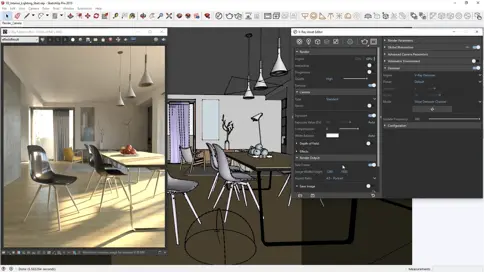V-Ray vs Corona
.webp)
V-Ray and Corona Renderer are two of the most popular graphics engines. Both programs are owned by the same company, Chaos, and are becoming increasingly similar, making it difficult for professional visualizers to choose the right software.
Both V-Ray and Corona will require some time with training videos and practicing on a few projects. Corona has always been the more popular Renderer, as the training tends to go more quickly and the learning curve is not as steep. Corona has also been known to work better and faster than its competitor. However, V-Ray may still give Corona a run for its money.
.webp)
Compatibility with other softwares
Let’s analyze which programs are compatible with V-Ray and Corona Renderer. These engines are most commonly used along with 3ds Max, because it’s one of the first 3D graphics software that has a large number of users. The first versions of both engines were made specifically for 3ds Max and later adapted to other modeling programs.

V-ray appeared on the world 3D graphics scene in 1997 and quickly became the most popular rendering software. Soon afterward, V-ray adapted by adding new settings and updating to new versions for various other modeling programs (not just 3ds Max) including SketchUp, Rhino, Revit, Maya, Cinema 4D and many others.

Corona Renderer appeared in 2009 as a diploma project of Czech developer Ondrej Karlik and it did not take long for this renderer to become popular in architectural visualization due to its simplicity and physical correctness. To date, Corona is fully operational only in conjunction with 3ds Max and Cinema 4D.
Compared to Corona, which is primarily used with 3ds Max, the range of programs that allow you to use V-ray is somewhat wider. At the same time, Corona renderer is compatible with third-party plugins: Forest Pack, Quixel Megascans, RailClone, etc.

Material Libraries

Corona's Materials has arguably the most comfortable interface and the clearest settings. It allows you to achieve photo-listings in rendering without any extra effort. This is also facilitated by a rich and free library of materials, which is constantly updated.
Setting up a physically correct display of objects in Corona does not require additional time - even light in the scene for rendering can be set automatically. Although these parameters may not be flexible enough, it is likely that when changes are made to the standard settings, the visualization will look unnatural and the program will warn about this.
Although the V-ray material editor is inferior to Corona in usability, it has a wider set of functions. This includes a large number of flexible settings that allow you to not only render any material but also create your own. However, without customization skills in both Corona and V-ray, there is a risk of making a mistake and ruining the render. Either way, to achieve photorealism, you need sufficient experience in the program.
V-ray has a large paid library of realistic materials. It can be found on the developer’s website. It is also possible to create stylized unrealistic materials in V-ray - one of the important features of the engine that makes it an ideal software for experiments with graphics.
Luckily for many visualizers that don't want to be limited to just one engine, V-ray and Corona allow for easy mutual export of already created materials: a scene created for V-ray can be converted into a scene for Corona in a single click. From Corona to V-ray, it is a bit more difficult to convert scenes, but it is not a problem for an experienced user.

Computer Stuffing
Rendering engines were previously thought to use processing power (CPU) and an amount of random access memory (RAM). Recently, the developers of the engine have been trying to redistribute the load from the rendering process so that it is completely absorbed by the resources of the video card (GPU).
This has become an important topic because of the rapid development of real-time engines used for video games (Unreal Engine, Unity). Real-time engines render images at the highest speed and use video card resources. Due to the constant demand for game computers with powerful video cards, iron manufacturers emphasize improved and cheaper video cards, and software manufacturers have to try to keep up with these changes.
Engines working primarily on video card resources include FStorm, Iray and Redshift. Recently, V-ray has also joined them; the load in it is distributed to the CPU, GPU and RAM. Corona stays true to the Proudly CPU Based principle - RAM and CPU are the main components of rendering.
RAM, CPU and GPU
The minimum amount of RAM for creating visualizations in Corona and V-ray is approximately the same - from 16 GB. However, Corona uses almost double the amount of RAM since its settings are initially changed for maximum realism.
.webp)
For example, if you use the Light Mix function to adjust the temperature of the colour and the intensity of the light sources directly during the rendering or after the rendering, Corona will require significantly more RAM. For complex and large projects in Corona, it takes about 128 GB, while in V-ray, it is enough for 32 GB or 64 GB.
The CPU is used 100% only during image rendering: the more powerful the CPU, the faster the image appears - a common rule for all engines. If your computer does not combine rendering with other tasks (for example at night), it does not need a powerful and expensive processor with a lot of cores: Corona has a list of suitable CPUs, they are also suitable for V-ray.
Video card rendering in V-ray has two effects: noise pressure and optical effects - these V-Ray operations are performed with GPU capacity. Corona does not use GPU, but the graphics card does determine the convenience of the working process - the more powerful the GPU, the faster you can see the quality image on the preview.
Which render engine is the best?
Now the differences between the engines are practically eliminated, but most users appreciate the convenience of Corona and do not plan to return to V-Ray. For newcomers, however, the popularity of the program should not be the only factor.
Select the visualization engine based on the simulation tool.
- If you use SketchUp or Rhinoceros, your version must be V-Ray. If you want to customize 3D model export to 3ds Max or Cinema 4D, you can start with Corona Renderer. For ArchiCAD users, only the beta version of the engine is available.
Find out what programs and engines are being used in the companies you want to work for.
- Using one software within a team will save time and effort on scene conversion.
If you plan to visualize professionally, you can master both engines, and the choice between Corona and V-Ray will depend on the specifics of the project and the specific tasks. Teams of professional visualizers can work both in the same engine and share responsibilities among themselves depending on the skills of participants and their tools.


Become part of our talented 3D designer community!
Join the RenderThat Talent Network to get access to exclusive projects, fun at work, and remote working opportunities. Get connected with top companies and showcase your talent across the world.



